MEV-1 & 2 (Mission Extension Vehicle-1 and -2)
EO
Operational (nominal)
Northrop Grumman
Northrup Grumman (formerly Orbital ATK), a commercial company based in Virginia, USA, developed the first commercial servicing satellites, Mission Extension Vehicle-1 (MEV-1) and Mission Extension Vehicle-2 (MEV-2). Launched in October 2019 and August 2020 respectively, MEV-1 and MEV-2 were designed to service fully functional but ageing satellites. MEV-1 provides life-extending services by taking over the propulsion and attitude control functions to steer, point and relocate the client spacecraft, while MEV-2 acts as fuel for a functioning satellite without means of significant propulsion.
Quick facts
Overview
| Mission type | EO |
| Agency | Northrop Grumman |
| Mission status | Operational (nominal) |
| Launch date | 09 Oct 2019 |
| CEOS EO Handbook | See MEV-1 & 2 (Mission Extension Vehicle-1 and -2) summary |
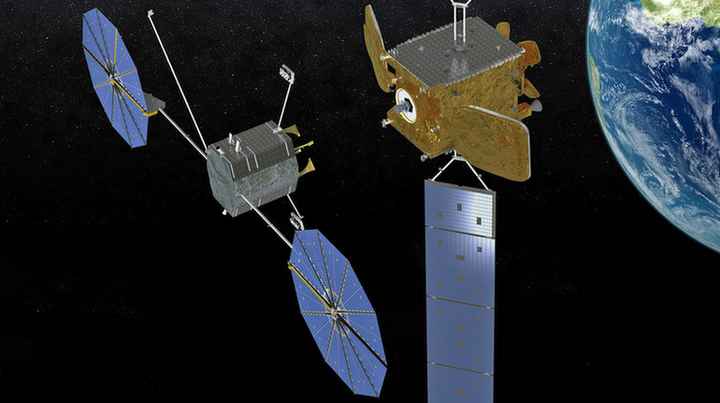
Summary
Mission Capabilities
Intelsat became the first customer of the satellite life extension service, with MEV-1 being successfully docked to Intelsat 901 in February 2020 and MEV-2 to Intelsat 10-02 in April 2021. Each vehicle has a 15-year design life with the ability to perform numerous dockings and undockings during its lifespan. The current Intelsat mission extension services by MEV-1 and MEV-2 are each planned for a five year period.
Northrup Grumman plans to establish a fleet of space logistics vehicles, working closely with agencies including NASA, DARPA (Defense Advanced Research Projects Agency) and USAF (United States Air Force) to develop next generation technologies including robotics and high power solar electric propulsion. Future services are expected to include fluid and gas replenishment, inspection and repair, replacement of parts and incorporation of auxiliary propulsion, navigation, power and payloads. Aside from commercial uses, future generation MEVs are proposed to service military spacecraft in cooperation with the Department of Defense (US DoD).
Performance Specifications
MEV-1 was launched in October 2019 by ILS (International Launch Services) and took approximately four months to reach Intelsat 901 using its electric propulsion system. MEV-2 was launched in August 2020 by Ariane Space, taking nearly eight months to reach its client spacecraft Intelsat 10-02.
Once docked, MEV-1 used its own thrusters and fuel supply to control the orbit of the customer satellite. Conversely, MEV-2 does not control the orbit but instead acts as a new engine and fuel tank to extend its client spacecraft’s life. Once the customer no longer desires this service, it will undock and move to a new client’s vehicle.
Space and Hardware Components
MEV-1 and MEV-2 are based on the GEOStar 3 bus that is modified to safely dock with an orbiting satellite in the geosynchronous orbit. These added features include a suite of integrated proximity sensors and a simple mechanical docking system that attaches to existing features on the client satellite. The docking system is compatible with approximately 80% of geosynchronous satellites on orbit. MEV-1 and MEV-2 have a mass of 2330 kg and 2875 kg respectively, with hybrid chemical and electric propulsion systems, full six degrees of freedom operational control, 10kW solar arrays, precision star trackers and a momentum wheel attitude control.
MEV-1 and MEV-2 (Mission Extension Vehicle-1 and -2)
Spacecraft Launch Mission Status References
In April 2016, Orbital ATK Inc. has signed with Intelsat S.A. to become the first customer for Orbital ATK’s new satellite life extension service. As one of the world’s leading commercial satellite services providers, Intelsat has a long track record for incorporating innovative satellite technologies into its global operations. Under the agreement, Orbital ATK will manufacture, test and launch the first CSV (Commercial Servicing Vehicle), the MEV-1, which incorporates flight-proven technologies the company has used in its commercial satellite and space logistics businesses. After successfully completing a series of in-orbit tests, the MEV-1 will begin its mission extension service for Intelsat in 2019. 1)
According to David W. Thompson, Orbital ATK’s President and Chief Executive Officer, ”The MEV-1 demonstrates the combined capabilities of Orbital ATK following the merger of our two legacy companies last year. The MEV-1 benefits from the capabilities in space logistics that both companies had developed. This new service is synergy at its best and presents an opportunity for Orbital ATK to open a new market in commercial space. There is a vital need to service fully functional but ageing satellites in both commercial and government markets. Backed by our continued investment, today’s announcement signals that we are just getting started in expanding our CSV fleet to provide a diverse array of in-space services in the future.”
Orbital ATK will introduce in-orbit satellite servicing with the Mission Extension Vehicle-1, which is based on the company’s GEOStar spacecraft bus platform. Controlled by the company’s satellite operations team, the MEV-1 uses a reliable, low-risk docking system that attaches to existing features on a customer’s satellite. The MEV-1 provides life-extending services by taking over the propulsion and attitude control functions. The vehicle has a 15-year design life with the ability to perform numerous dockings and undockings during its life span.
The launch of the first MEV is slated for late 2018 with in-orbit testing and demonstration to be performed with an Intelsat satellite. This testing is scheduled for completion by early 2019. MEV-1 will then relocate to the Intelsat satellite scheduled for the mission extension service, which is planned for a five-year period. Intelsat will also have the option to service multiple satellites using the same MEV.
The DoD (Department of Defense) is also interested in using Orbital ATK’s new in-orbit satellite life extension vehicle to service military in addition to commercial spacecraft. 2)
Space Logistics LLC, a wholly owned subsidiary of Orbital ATK, provides cooperative in-orbit satellite life extension and maneuvering services to geosynchronous satellite operators using its MEV (Mission Extension Vehicle). The MEV docks with customers’ existing satellites providing the propulsion and attitude control needed to extend their lives. 3)
The Orbital ATK vision is to establish a fleet of space logistics vehicles to meet a variety of future needs. Orbital ATK continues to make deep investments in on-orbit servicing and is working closely with U.S. Government agencies including NASA, DARPA, the USAF and others to develop the next generation space logistics technologies. These technologies include robotics and high power solar electric propulsion to enable future services building upon our keep-it-simple approach to satellite life extension. These future services are expected to include: 4)
• Fluid and gas replenishment
• Inspection & repair
• Replacement or enhancement of parts
• Incorporation of auxiliary propulsion, navigation, power, payloads and other functions to enhance the performance or extend the satellite's life.
Note: On June 6, 2018, Northrop Grumman Corporation announced it has closed the acquisition of Orbital ATK Inc. (“Orbital ATK”), a global leader in aerospace and defense technologies. Orbital ATK is now Northrop Grumman Innovation Systems (NGIS), a new, fourth business sector. 5)
Spacecraft
MEV-1 is based on the GEOStar 3 bus that is modified to safely rendezvous and dock with an orbiting satellite in the geosynchronous orbit. To do so, a suite of integrated proximity sensors is used to reliably and safely rendezvous with the client satellite. The MEV-1 then utilizes a simple mechanical docking system that attaches to existing features on the client satellite creating a firm connection between the MEV and the client satellite. This docking system is compatible with an estimated 80 percent of all geosynchronous satellites on orbit today. 6)
MEV Bus Features:
• Full 6-DOF (Degree of Freedom) operational control
• Redundant RPOD (Rendezvous Proximity Operation and Docking) sensor suite
• Docking mechanisms to interface with standard liquid apogee engines and launch adaptors
• Semi-autonomous rendezvous and proximity operations
• High and low rate downlink for real-time ground operator situational awareness
• Hybrid chemical and electric propulsion systems
• Electric propulsion thrust vector control for station keeping and momentum management
• Significant delta-V capability
• High precision star trackers and momentum wheel attitude control
• Redundant and high reliability 15+ year design life
• High heritage derived from GEOStar™, Cygnus™ and other Orbital ATK programs
• Significant hosted payload capability.
RPOD (Rendezvous Proximity Operation and Docking) Payload | • Redundant imaging systems for 6-DOF POSE |
Structure | • Stacked design for dual launch |
Guidance Navigation & Control | • Standard GEO ACS – STAs, MIMUs, CSSs |
Power | • 10 kW solar arrays |
Telemetry, Commanding & Ranging | • 2 x C + 1 x Ku band flexible frequency |
Avionics | • Fully cross strapped architecture |
Spacecraft mass | • 2330 kg |
MEV-1 docks to client vehicles in geosynchronous orbit using existing satellite features to provide attitude and orbit control of the combined vehicle stack. MEV-1 has the ability to dock and undock several times during its 15 year design life, allowing it to service multiple customers. NGIS initial service, using the MEV-1, will extend the life of the Intelsat-901 satellite for five years. NGIS is pioneering the future of space by demonstrating the fundamentals of satellite servicing with MEV-1.
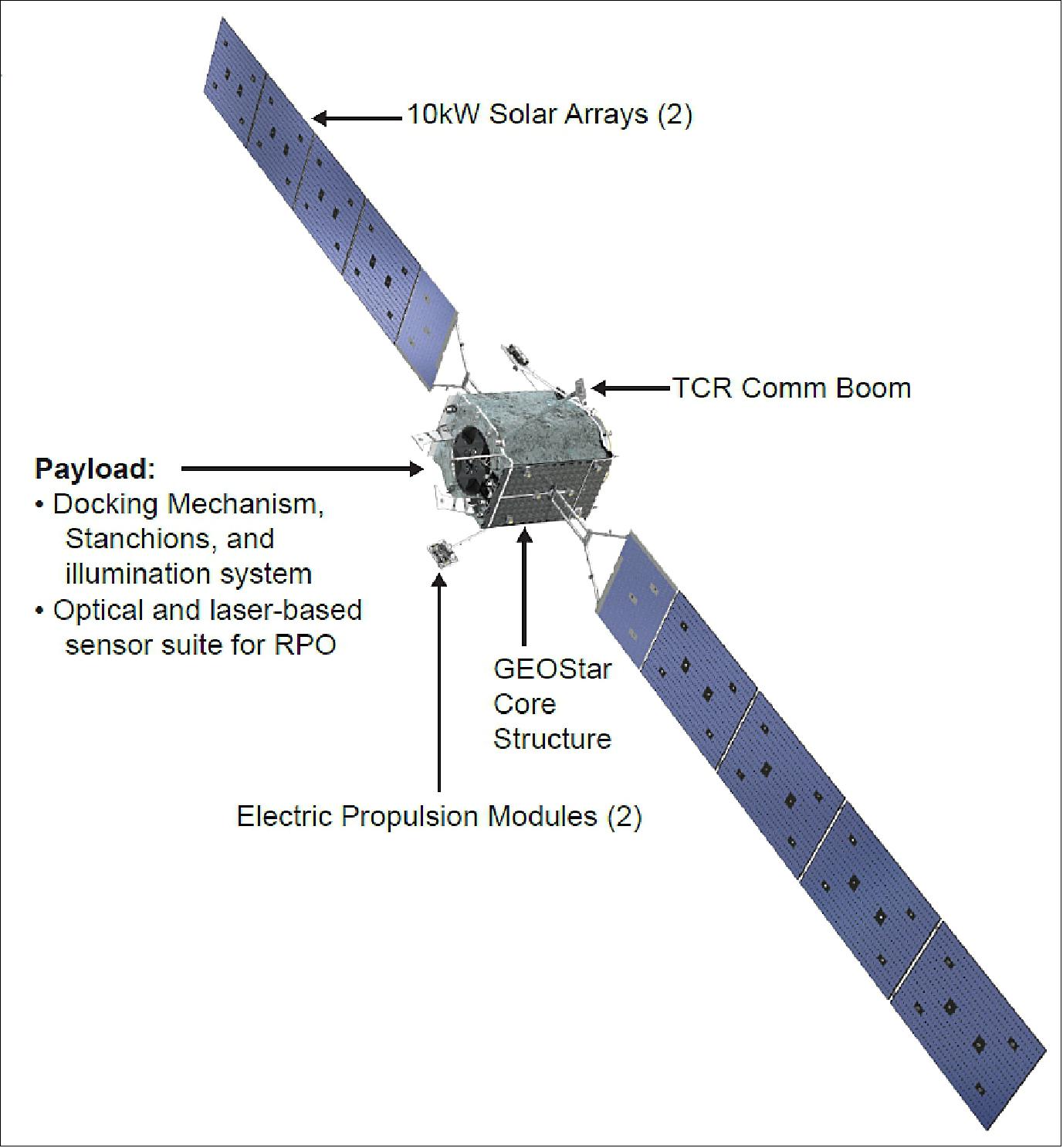
Development Status
• June 30, 2020: Northrop Grumman Corporation announced today the arrival of the company-built Galaxy 30 (G-30) spacecraft for Intelsat and the Mission Extension Vehicle 2 (MEV-2) at the launch site in Kourou, French Guiana. The vehicles are scheduled to launch late July 2020, in a stacked configuration onboard an Ariane 5 rocket. 7)
- ”These satellites are excellent examples of our established leadership and innovation in the industry,” said Frank DeMauro, vice president and general manager, tactical space systems, Northrop Grumman. “The Galaxy 30 spacecraft will fill a critical need for Intelsat, while our second MEV will provide game-changing life extension services and continue to define a new market.”
- Galaxy 30 (G-30) is the 11th Northrop Grumman-built satellite purchased by Intelsat and the first in its Galaxy fleet replacement program, dedicated to video distribution and broadcast services. G-30 carries a C-band payload and will be integral to the U.S. C-band spectrum transition plan that Intelsat is collaborating on with the Federal Communications Commission. Additionally, G-30 includes Ku- and Ka-band payloads to support broadband applications as well as the Wide Area Augmentation System (WAAS) hosted payload for the Federal Aviation Administration. G-30 is based on Northrop Grumman’s flight-proven GEOStar-2 platform.
- Intelsat also recently selected Northrop Grumman to build two C-band satellites, which are the 12th and 13th purchased from the company.
- The Mission Extension Vehicle is the industry’s first satellite servicing vehicle, designed to dock with geostationary satellites whose fuel has nearly depleted. Once docked, MEV uses its own thrusters and fuel supply to control the orbit of the customer satellite. When the customer no longer desires MEV’s service, it will undock and move to a new client’s vehicle.
- The company’s first Mission Extension Vehicle, MEV-1, launched October 9, 2019, and completed its historic docking with the Intelsat 901 spacecraft February 25, 2020. This marked the first time two commercial satellites have docked in orbit. IS-901 resumed communications services April 2, 2020.
- MEV-2 will dock with the Intelsat 1002 (IS-1002) in early 2021. MEV-2 is the second Mission Extension Vehicle supplied by Space Logistics LLC, a wholly owned subsidiary of Northrop Grumman.

• January 4, 2018: IntelSat S.A. awarded a contract to Orbital ATK for a second Mission Extension Vehicle (MEV-2) to provide life extension services for an Intelsat satellite. Orbital ATK is now producing MEV-1, the industry’s first commercial in-space satellite servicing system, for Intelsat with a launch scheduled for late 2018. Under this new agreement, Orbital ATK will manufacture, test and launch MEV-2 and begin mission extension services in mid-2020. The production of the second MEV is part of Orbital ATK’s longer-range plan to establish a fleet of in-orbit servicing vehicles that can address diverse space logistics needs including repair, assembly, refueling and in-space transportation. 8)
• September 11, 2017: The MEV-1 spacecraft successfully completed its critical design review earlier this year and is now in production, with about 75 percent of the platform and payload components already delivered to the company’s Satellite Manufacturing Facility in Virginia. The spacecraft will begin system-level testing in the spring of 2018, with launch planned late next year. 9)
- Work on the spacecraft spans multiple locations across the company. Orbital ATK’s spacecraft components division is manufacturing the structures, propellant tanks and solar arrays for MEV-1 at locations in San Diego and Goleta, California. Additionally, the Rendezvous, Proximity Operations and Docking (RPOD) laboratory located at the company’s headquarters in Dulles, Virginia, is testing the sensors, actuators and control algorithms which allow for the tracking, approach and docking with a client spacecraft.
• June 20, 2017: Orbital ATK announced the completion of its RPOD (Rendezvous, Proximity Operations and Docking) system preliminary design review. The RPOD system comprises the sensors, actuators and control algorithms which allow for the detection, tracking, and safe approach to a client spacecraft. The company’s first Mission Extension Vehicle (MEV-1) will provide satellite life extension services to Intelsat S.A. beginning in 2019. 10)
- Orbital ATK has been working with several NASA centers on various elements for the company’s MEV (Mission Extension Vehicle) RPOD system as part of a Collaboration for Commercial Space Capabilities SAA (Space Act Agreement) established in 2014. In addition to completing the RPOD preliminary design review, NASA has also given input on the RPOD concept of operations review, electrostatic discharge management and lighting designs.
- “Our partnership with NASA through this Commercial Space Capabilities Space Act Agreement is an excellent example of how government can support commercialization of complex technology development,” said Frank Culbertson, President of Orbital ATK’s Space Systems Group. “NASA’s collaboration and feedback are helping us ensure that we are on the right track to delivering a safe and successful mission with our MEV product while pioneering a new market in satellite servicing.”
- The SAA allows Orbital ATK’s Advanced Programs Division and NASA to collaborate on technologies and new product development that meet the needs of the emerging space logistics industry. The SAA is an unfunded partnership through NASA’s Collaborations for Commercial Space Capabilities Office at the agency’s Johnson Space Center in Houston, Texas. The agreement defines principal milestones on Orbital ATK’s scheduled commercial activities and allows NASA to offer assistance and feedback on key developments. By leveraging NASA expertise, the company will continue to enhance its innovative in-orbit programs for government and commercial space customers.
• April 12, 2016: Orbital ATK has signed Intelsat as its first customer for a revived satellite life extension program as part of the company’s ambitions to create a growing market for satellite servicing for commercial and government customers. 11)
- Orbital ATK is offering the Mission Extension Vehicle (MEV), a spacecraft designed to rendezvous with a commercial satellite and dock to the nozzle of its apogee kick motor and surrounding adapter ring. The MEV would then take over propulsion and attitude control for the satellite, offering up to five years of extended life.
- Intelsat has agreed to be the customer for the first MEV mission, named MEV-1 and scheduled for launch in 2018. MEV-1 will first dock with a retired satellite in a graveyard orbit above stationary orbit to test its systems, then dock with an active Intelsat satellite to extend its life for five years.
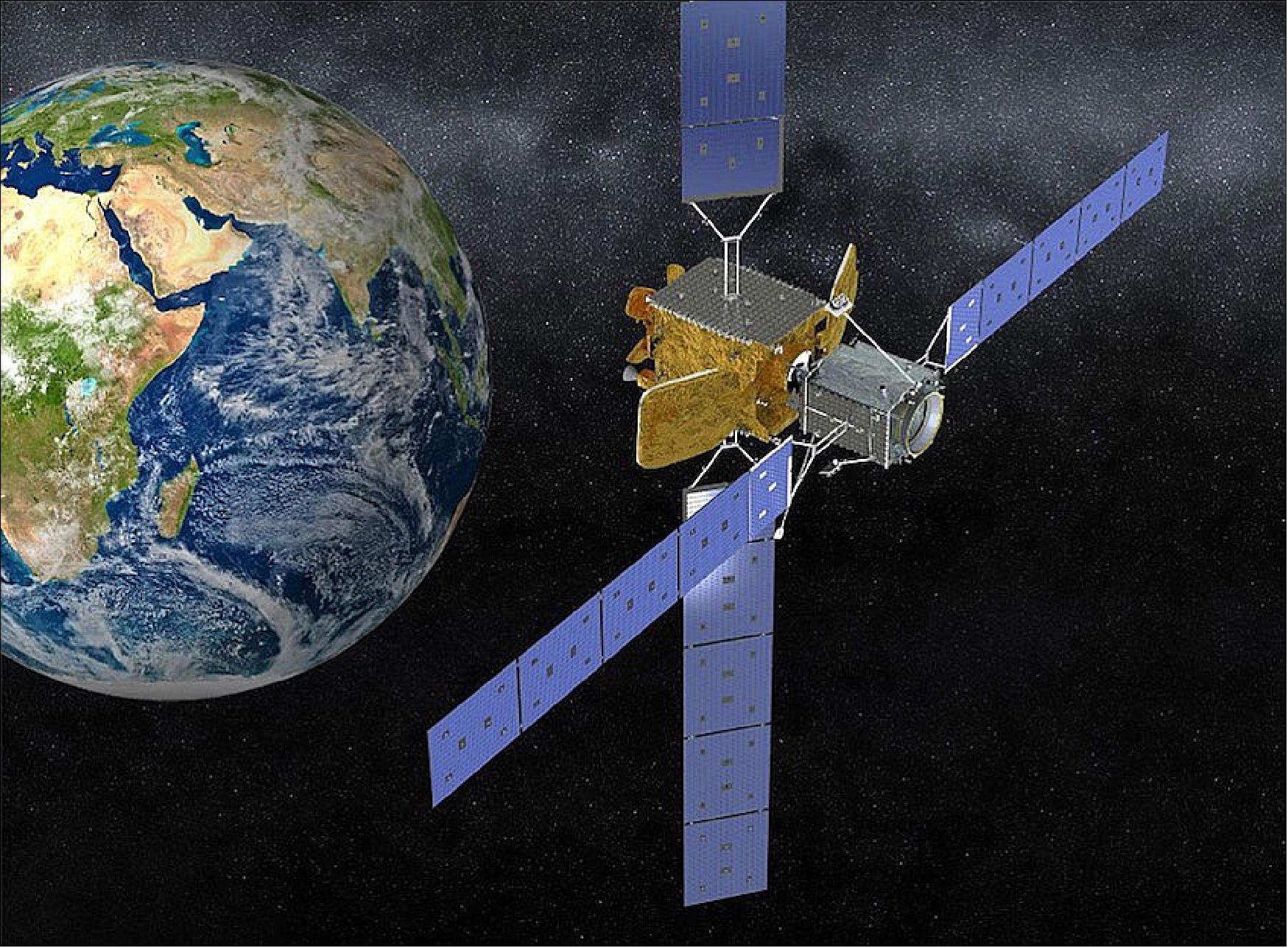
Launch: The MEV-1 spacecraft was launched on 9 October 2019 as a co-passenger with the Eutelsat 5WB satellite, also built by NGIS (formerly Orbital ATK). The launch provider was ILS (International Launch Services) and the launch vehicle was a Proton-M Briz-M . The launch site was Baikonur, Kazakhstan. 12)
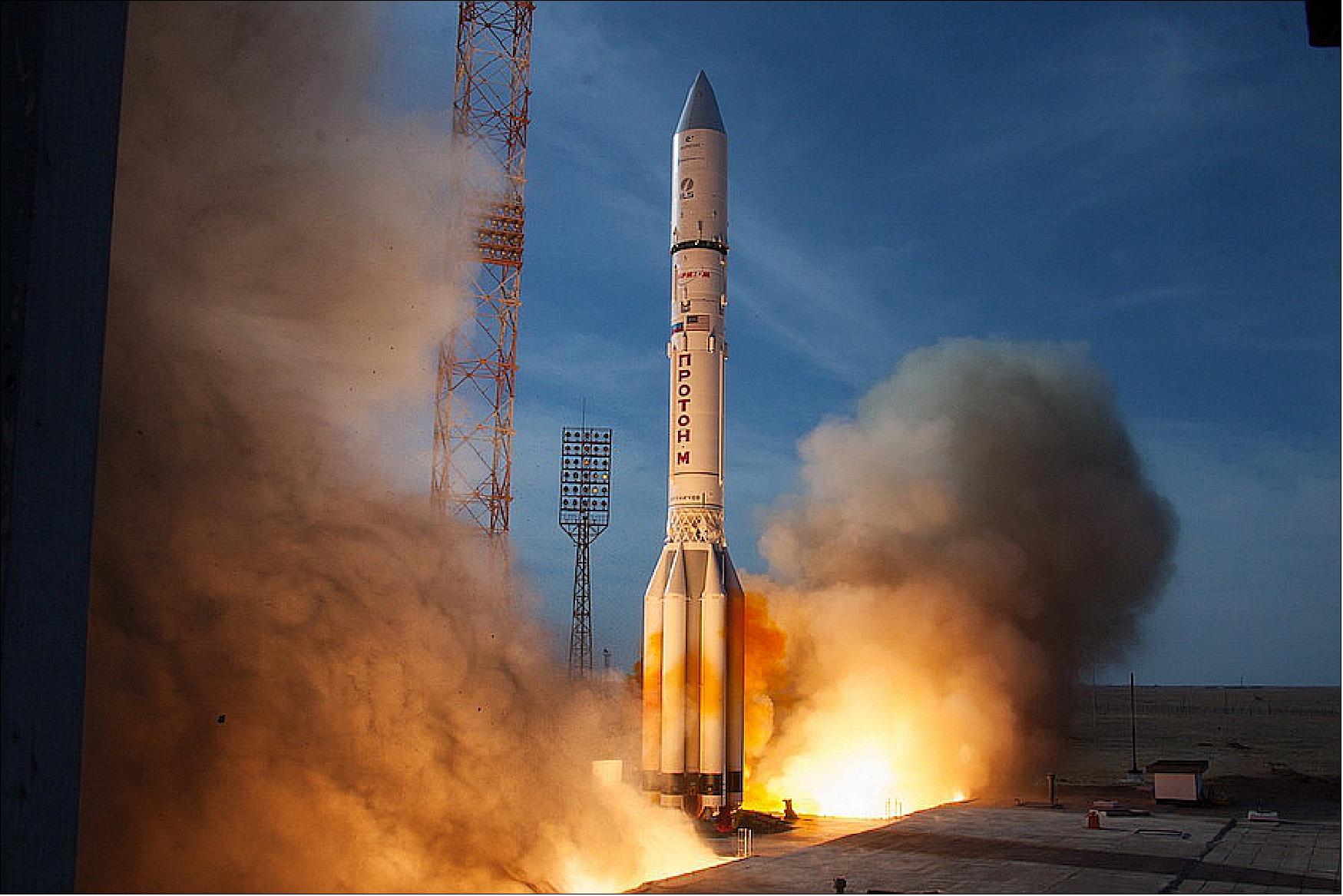
The launch sequence spanned nearly 16 hours from liftoff through separation of both satellites from the Breeze M upper stage. The two satellites were released into orbits ranging between around 12,050 km to more than 65,000 km, at an inclination of 13.3-13.4º.
The MEV-1 (Mission Extension Vehicle-1) manufactured by Northrop Grumman, is the first commercial satellite servicing spacecraft ever built. It will dock with the Intelsat-901 satellite in geostationary orbit and take over propulsion, extending the client satellite’s lifetime.
The 2,330 kg MEV-1 will take up to three and a half months to reach geostationary orbit using its electric propulsion, Joe Anderson, SpaceLogistics’ vice president of operations and business development, said Oct. 1 during a Consortium for Execution of Rendezvous and Servicing Operations event. Once connected to Intelsat-901 in an inclined geosynchronous orbit, the combined stack will move a few hundred kilometers higher into a graveyard orbit above most operational satellites, for testing.
The MEV-1 spacecraft is owned by Space Logistics LLC, a wholly-owned subsidiary of Northrop Grumman. Using ion thrusters, the spacecraft will gradually circularize its altitude to geostationary altitude over the next three-and-a-half months, according to Joe Anderson.
In the meantime, Intelsat controllers will send commands for the Intelsat 901 satellite to leave its operating position at 18 degrees west longitude and raise its altitude by nearly 300 km, to the so-called GEO graveyard orbit, where geostationary satellites are typically decommissioned.
“We will then, probably in the late January timeframe, rendezvous and dock with the spacecraft in that graveyard orbit,” Anderson said in an interview with Spaceflight Now. “We will do a little bit of testing there to demonstrate the capabilities of the combined stack, and then we will begin relocating it to its new operational location.”
The Mission Extension Vehicle will attempt its first docking in the GEO graveyard orbit to reduce the risk to other active satellites from space debris in the event of an accident.
The MEV is different from other satellite servicing concepts because it is strictly used for steering, pointing and relocating another spacecraft that is running low on propellant. The servicer will not refuel Intelsat’s satellites, which were never designed for dockings.
The Mission Extension Vehicle will latch on to the main engine of Intelsat-901, and other future client satellites. A liquid apogee engine is mounted to the base of about 80 percent of the communications satellites in geosynchronous orbit. The thruster is only used in the first few weeks after launch to put the satellite into its final orbit, then never fired again (Ref. 13).
Space Logistics Company
SpaceLogistics LLC, a wholly owned subsidiary of Northrop Grumman, provides cooperative space logistics and in-orbit satellite servicing to geosynchronous satellite operators using its fleet of commercial servicing vehicles. Our initial servicing vehicle, the Mission Extension Vehicle (MEV)™ docks with customers' existing satellites providing the propulsion and attitude control needed to extend their lives. We have now introduced our next generation system, Mission Extension Pods (MEPs)™, which is a smaller and less expensive life extension service that only performs orbit control. The MEPs are installed by a robotic servicing vehicle called the Mission Robotic Vehicle (MRV)™ which can perform all the functions of an MEV while adding new robotic capabilities for additional services.
Our life extension services are compatible with virtually all geosynchronous satellites with minimal interruption to operations. They enable satellite operators to significantly extend satellite mission life, activate new markets, drive asset value and protect their franchises. SpaceLogistics delivers life extension services that are flexible, scalable, capital-efficient and low-risk.
Our life extension services are compatible with virtually all geosynchronous satellites with minimal interruption to operations. They enable satellite operators to significantly extend satellite mission life, activate new markets, drive asset value and protect their franchises. SpaceLogistics delivers life extension services that are flexible, scalable, capital-efficient and low-risk.
SpaceLogistics is a global leader in in-orbit satellite servicing systems and services for commercial and government customers. The company is a wholly owned subsidiary of Northrop Grumman.
Launch
Launch: The MEV-2 spacecraft was launched on August 15, 2020 (22:04 UTC) on an Ariane 5 ECA rocket, carrying three spacecraft from the Guiana Space Centre in Kourou, French Guiana. The rocket carried three spacecraft into GTO (Geosynchronous Transfer Orbit): the Galaxy-30 communication satellite for Intelsat stacked atop Northrop Grumman’s second Mission Extension Vehicle, MEV-2, in its upper berth. Ariane 5’s lower berth housed the BSAT-4b satellite for Japanese operator BSAT, separated from the other payloads by a protective case. Galaxy-30, with a launch mass of 3298 kg, was the first to be released after about 27 minutes. The 2875 kg MEV-2 was released about seven minutes later. 15)
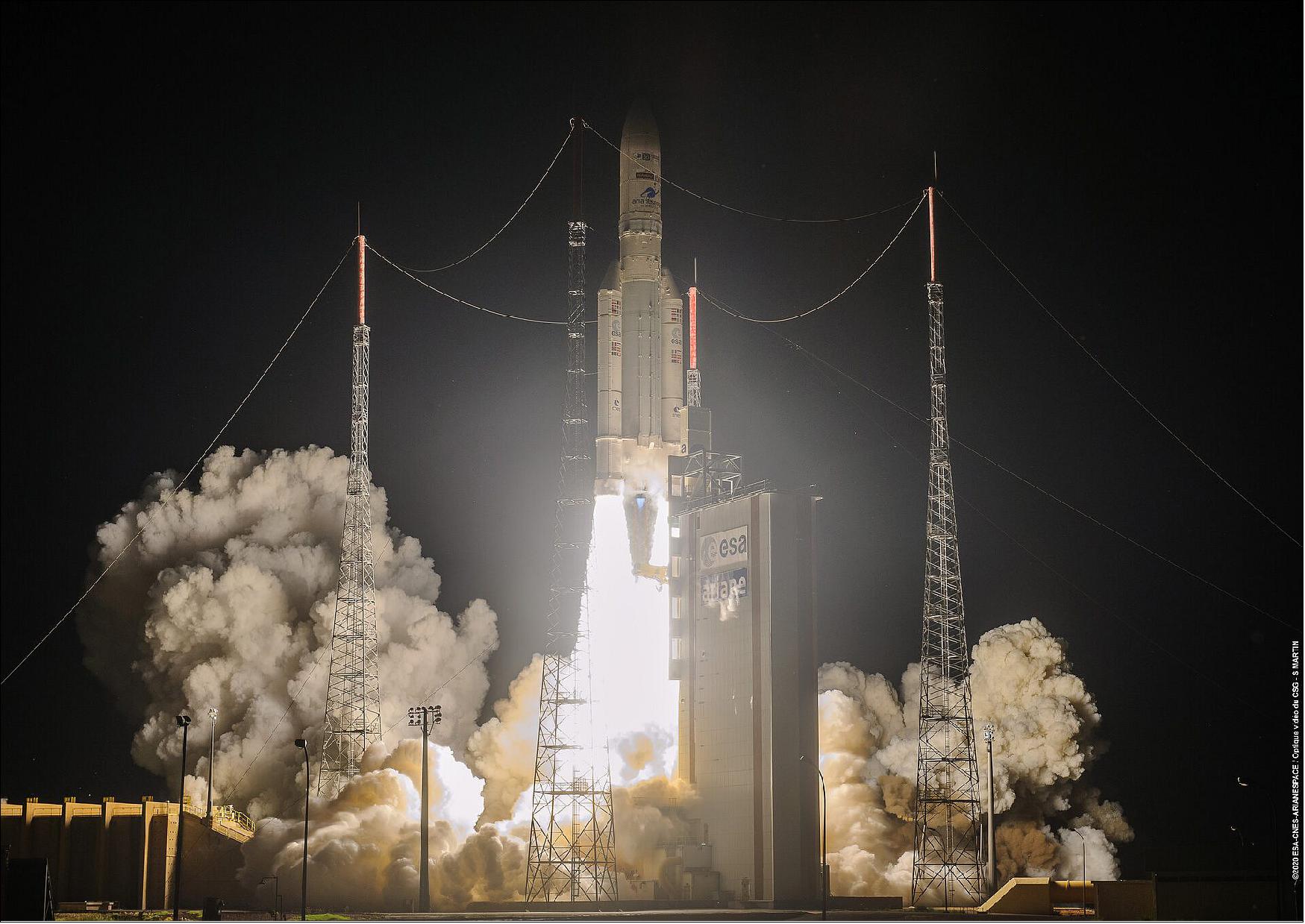
The performance requested for this launch was about 10,468 kg. The satellites totalled about 9,703 kg, with payload adapters and carrying structures making up the rest.
This was the first launch following the restart of operational activities at Europe’s Spaceport in French Guiana, after the suspension of launch campaigns that was imposed on 16 March 2020 due to COVID-19 measures.
Also on this flight, there are four new technical modifications to Ariane 5.
1) New onboard technology called Kassav is the first version of an autonomous tracking kit developed by CNES in partnership with ArianeGroup. Independently of the operations of the launch vehicle, Kassav uses dedicated telemetry to send real-time information on Ariane’s position and speed to the Flight Safety team at Europe’s Spaceport.
2) CNES funded the kit development and checks for safe use while ESA funded and oversaw the installation on the launch vehicle. Kassav will now be used on all Ariane 5 and Ariane 6 flights.
3) A further modification to Ariane 5’s fairing will minimize depressurization at separation as this two-part nose cone is jettisoned away from the launch vehicle in space. Manufactured by RUAG Space Switzerland, the fairing protects the customer payloads from the acoustic, thermal and aerodynamic stresses during the ascent. New hardware ensures that venting ports around the base of the fairing remain fully open on the way to space, allowing the pressure to equalize within the fairing prior to opening and falling away from the rocket.
4) This alteration is part of the preparation for the launch of the NASA/ESA/CSA James Webb Space Telescope (JWST) set for October 2021. These changes mitigate concerns that residual air pressure in the folds of the JWST sunshield membranes could cause high stresses at the time of fairing separation, potentially damaging sensitive components.
5) The vehicle equipment bay (VEB), the ‘brain’ of the launch vehicle controlling the avionics, guidance system and other key components that interfaces with the upper stage, has been made 85 kg lighter on its central cone thanks to the use of new material and removal of metallic interfaces. This modification increases Ariane 5’s total payload capability to geostationary transfer orbit to 10,300 kg.
During the redesign of the cone, the membrane that separates the VEB and the upper stage was also made a few kilograms lighter using innovative manufacturing technologies. This membrane will continue to be used on all Ariane 5 flights and also incorporated in the upcoming Ariane 6.
Mission Status
• April 12, 2021: Northrop Grumman Corporation and the company’s wholly-owned subsidiary, SpaceLogistics LLC, have successfully completed the docking of the Mission Extension Vehicle-2 (MEV-2) to the Intelsat 10-02 (IS-10-02) commercial communications satellite to deliver life-extension services. The docking was completed at 1:34 p.m. EST. 16)
- Northrop Grumman is the only provider of flight-proven life extension services for satellites, and this is the second time the company has docked two commercial spacecraft in orbit. The company’s MEV-1 made history when it successfully docked to the Intelsat 901 (IS-901) satellite in February 2020. Unlike MEV-1, which docked above the GEO orbit before moving IS-901 back into service, MEV-2 docked with IS-10-02 directly in its operational GEO orbital location.
- “Today’s successful docking of our second Mission Extension Vehicle further demonstrates the reliability, safety and utility of in-space logistics,” said Tom Wilson, vice president, strategic space systems, Northrop Grumman and president, SpaceLogistics LLC. “The success of this mission paves the way for our second generation of servicing satellites and robotics, offering flexibility and resiliency for both commercial and government satellite operators, which can enable entirely new classes of missions.”
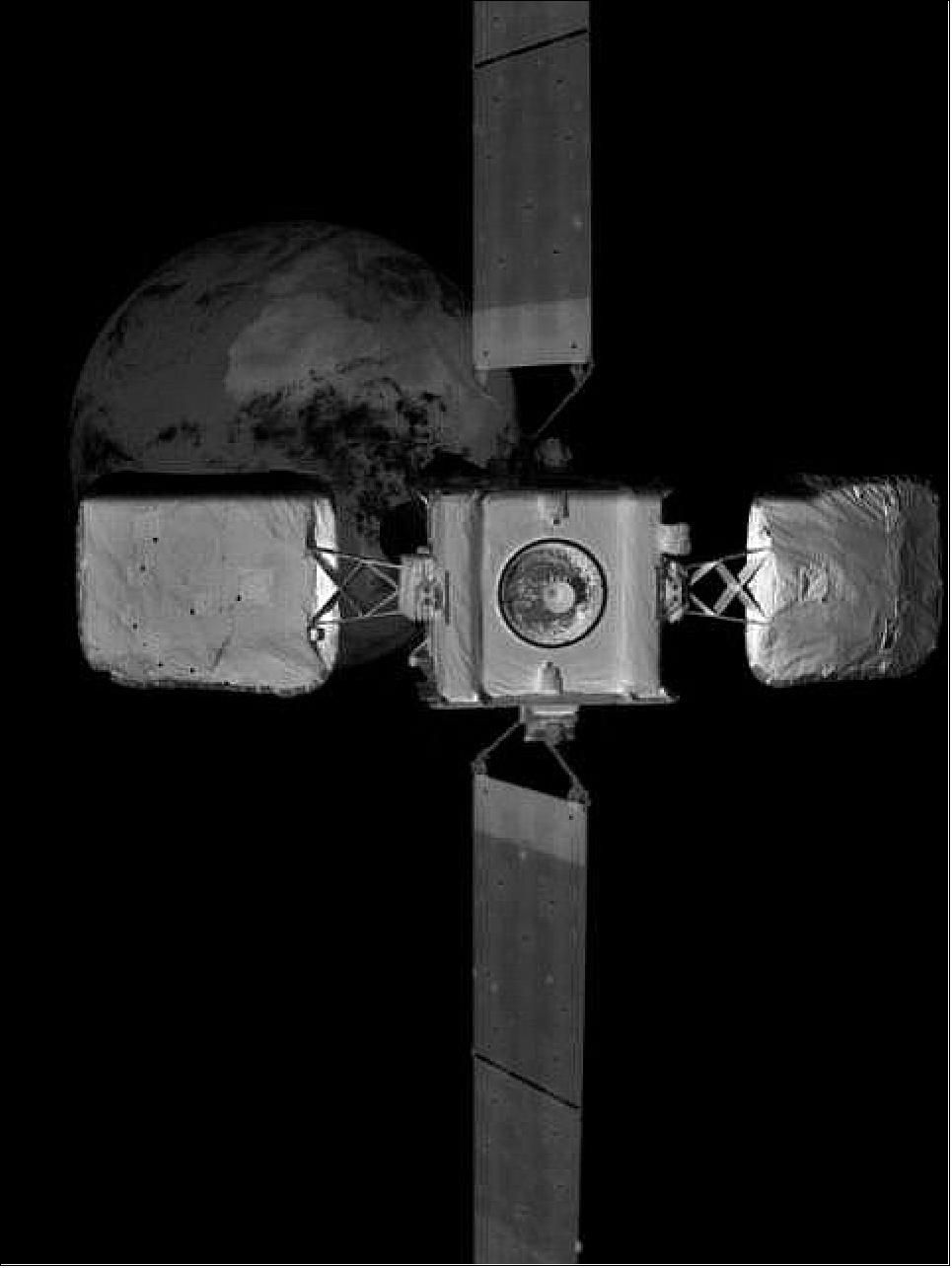
- Under the terms of Intelsat’s satellite life-extension servicing contract, MEV-2 will provide five years of service to IS-10-02 before undocking and moving on to provide services for a new mission.
- “Intelsat has pioneered innovations in space-based technology for more than five decades. We are proud to work side by side with Northrop Grumman on today’s groundbreaking mission, the first-ever docking of a communications satellite in GEO orbit,” said Intelsat Chief Services Officer Mike DeMarco. “Space servicing is a valuable tool for Intelsat in extending the high-quality service experience that our customers depend upon. Northrop Grumman’s MEV technology has helped us extend the life of two otherwise healthy and high-performing satellites, while focusing our innovation capital on advancing the Intelsat next-generation network – this technology is a ‘win-win’ for us.”
- The Mission Extension Vehicle is the first in Northrop Grumman’s lineup of satellite servicing vehicles, but following last year’s robotic servicing mission award from DARPA, the company is working with the agency on a mission that will feature the first-ever commercial robotic servicing spacecraft. This mission will expand the market for satellite servicing of both commercial and government client satellites with advanced robotics using the company’s Mission Robotic Vehicle (MRV) to conduct in-orbit repair, augmentation, assembly, detailed inspection and relocation of client satellites through robotics.
- To further complement its on-orbit servicing portfolio, Northrop Grumman is leveraging model based systems engineering to develop its Mission Extension Pods (MEPs) which will also provide critical life extension services to aging satellites. The MRV will be used to install these pods on existing in-orbit commercial and government client satellites to extend their mission lives. The company is targeting 2024 for launch of both the MRV and the initial MEPs.
• March 10, 2021: Northrop Grumman’s MEV-2 satellite servicer is performing close proximity operations with Intelsat’s in-orbit 10-02 spacecraft ahead of a docking attempt, SpaceNews has learned. 17)
- Both spacecraft remain healthy after being in close quarters to calibrate and test systems before MEV-2 backed off, according to a Northrop Grumman official.
- The company intends to release an update once it completes the docking.
- It is understood the satellite servicer’s predecessor MEV-1 made several close proximity operations maneuvers and approaches before successfully attaching to Intelsat-901 last year, enabling the 19-year-old satellite to resume services from April 2.
- MEV-2 has a similar design to MEV-1, but the two missions have distinct differences. While Intelsat-901 was no longer functioning as it languished in a graveyard orbit, Intelsat-10-02 has been active in geosynchronous orbit since 2004 and is carrying communications traffic.
- The two companies are working closely together to time approaches and the eventual docking for when it is most conducive to Intelsat’s business needs.
- MEV-2 is also not moving its satellite to a different orbit like MEV-1 did; instead it will act as a new engine and fuel tank to extend the spacecraft’s life.

- Demand for GEO life extension missions will grow to 75 satellites by 2030, according to a recent Northern Sky Research (NSR) forecast, representing a $3.2 billion cumulative market opportunity.
- NSR analyst Hussain Bokhari expects more than 230 in-orbit satellites will be serviced in some way during the next 10 years, with governments and militaries also driving demand in GEO and non-GEO. These missions include relocation, salvage and repair services.
- This growing market potential continues to attract new entrants, including Ukrainian startup Kurs Orbital with its plans to revive Soviet-era docking technology.
- However, Bokhari warned that the slow pace of technology development and confidence in in-orbit servicing capabilities, as well as a lack of clear technical and safe operating standards, threaten the market’s growth.
• April 17, 2020: Intelsat today announced that Intelsat 901 has returned to service following the successful docking with the first Mission Extension Vehicle (MEV-1) from Northrop Grumman Corporation and the company’s wholly-owned subsidiary, SpaceLogistics LLC, on February 25 – the first time that two commercial spacecraft docked in geostationary orbit. 18)
- Since the February rendezvous, MEV-1 has assumed navigation of the combined spacecraft stack reducing its inclination by 1.6° and relocating IS-901 to its new orbital location. Intelsat then transitioned roughly 30 of its commercial and government customers to the satellite on April 2. The transition of service took approximately six hours. IS-901 is now operating at the 332.5°E orbital slot and providing full service to Intelsat customers.
- Intelsat views life-extension services, like MEV technology, as a cost-effective and efficient way to minimize service disruptions, enhance the overall flexibility of its satellite fleet and better support the evolving needs of its customers.
- “With a focus on providing the best customer experience in our industry, Intelsat is proud to have pioneered this innovative first with Northrop Grumman. We see increased demand for our connectivity services around the world, and preserving our customers’ experience using innovative technology such as MEV-1 is helping us meet that need,” said Intelsat Chief Services Officer Mike DeMarco. “I want to thank Northrop Grumman, SpaceLogistics and our valued Intelsat customers, who put their trust in us to successfully execute this historic mission. As commercial space-servicing technology progresses, Intelsat looks forward to pioneering new applications in support of our customers’ continued success.”
- “Our partnership with Intelsat was critical to delivering this innovative satellite technology into operation,” said Tom Wilson, vice president, Northrop Grumman Space Systems and president, SpaceLogistics, LLC. “This historic event, highlighted by the first in-orbit rendezvous and docking of two commercial satellites and the subsequent repositioning of the two-spacecraft stack, demonstrates the business value that MEV offers to customers. Now that MEV-1 has successfully delivered on its mission to place the Intelsat 901 satellite back into operational service, we will continue to pioneer the future of on-orbit servicing through our multi-year technology roadmap leading to additional services such as inspection, assembly and repair.”
- Under the terms of the contract, Northrop Grumman and SpaceLogistics will provide five years of life extension services to IS-901 before returning the spacecraft to a final decommissioned orbit. MEV-1 will then be available to provide additional mission extension services for new clients including orbit raising, inclination corrections and inspections. Intelsat has already contracted with Northrop Grumman for a second MEV (MEV-2) to service Intelsat 1002 satellite later this year.
• February 27, 2020: Northrop Grumman Corporation and the company's wholly-owned subsidiary, SpaceLogistics LLC, have successfully completed the first docking of the Mission Extension Vehicle-1 (MEV-1) to the Intelsat 901 (IS-901) spacecraft in order to provide life-extension services. This historic accomplishment marks the first time two commercial satellites have docked in orbit and the first time that mission extension services will be offered to a satellite in geosynchronous orbit. 19) 20)
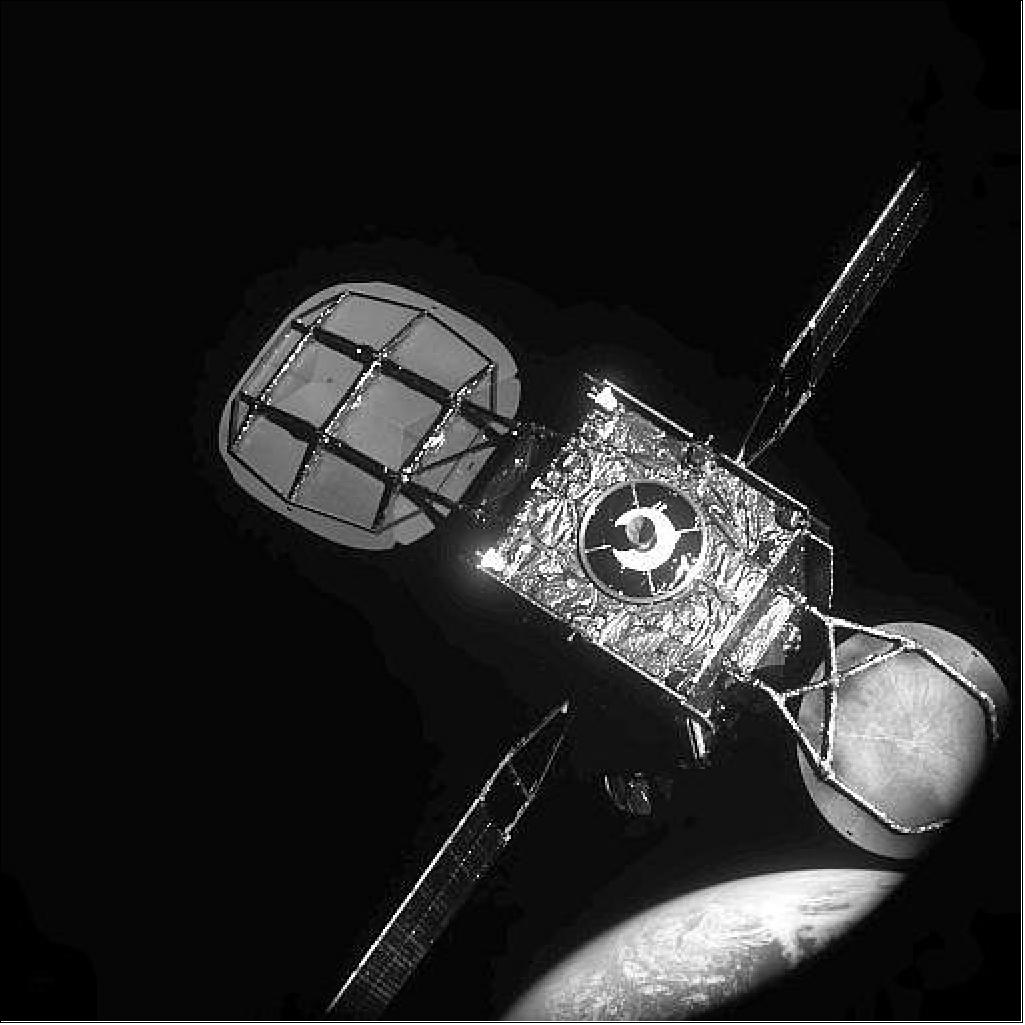
- MEV-1, launched Oct. 9, 2019, recently completed its orbit raising to an orbit approximately 180 miles above geosynchronous orbit. IS-901 is a fully operational communication satellite that is running low on fuel.
- Intelsat removed 901 from service in December 2019, transferring customers to other satellites in its extensive fleet, in order to raise its orbit to the same altitude as MEV-1 in preparation for docking. MEV-1 then completed the historic docking with IS-901 on February 25 at 2:15 a.m. ET. The combined spacecraft stack will now perform on-orbit checkouts before MEV-1 begins relocating the combined vehicle to return IS-901 into service in late March.
- "Our Mission Extension Vehicle provides an innovative, satellite life extension service," said Tom Wilson, president, SpaceLogistics LLC. "Together, Northrop Grumman, SpaceLogistics LLC and Intelsat have taken the first step in pioneering in-space logistics services for both commercial and government customers."
- "Intelsat has been at the forefront of innovation and game-changing space technology for decades. Pushing the boundaries of what's possible is in our DNA here - that's why we didn't hesitate to sign up to be MEV-1's first customer," said Mike DeMarco, executive vice president and chief services officer at Intelsat. "We're proud to make history with SpaceLogistics LLC and Northrop Grumman on this groundbreaking space milestone."
- Under the terms of the contract with Intelsat, MEV-1 will provide five years of life extension services to the IS-901 satellite before returning the spacecraft to a final decommissioning orbit. MEV-1 will then move on to provide mission extension services to a new client spacecraft.
- MEV-1 was designed and built at the Northrop Grumman's Dulles, Virginia, facility and utilizes a low-risk mechanical docking system that attaches to existing features on the client satellite. Once docked, MEV takes over the attitude and orbit maintenance of the combined vehicle stack to meet the pointing and station keeping requirements of the customer.
- MEV is designed for multiple docking and undockings and can deliver over 15 years of life extension services. The company is scheduled to launch its second Mission Extension Vehicle, MEV-2, later this year, which is contracted to provide service to a different Intelsat satellite.
- This life extension service is just the first step in an expansive technology development plan. The company's vision is to establish a fleet of satellite servicing vehicles that not only extend the life of satellites, but provide other services such as inclination changes and spacecraft inspections, as well as use advanced robotics technology to perform additional functions such as in-orbit repair and assembly.
- As the foundational architects of satellite technology, Intelsat operates the world's largest and most advanced satellite fleet and connectivity infrastructure. We apply our unparalleled expertise and global scale to connect people, businesses and communities, no matter how difficult the challenge. Intelsat is uniquely positioned to help our customers turn possibilities into reality - transformation happens when businesses, governments and communities use Intelsat's next-generation global network and managed services to build their connected future.
• February 4, 2020: According to Satnews Daily, the MEV-1 spacecraft has arrived in station and is now positioned in orbit a few hundred kilometers away from the target satellite to be rescued, namely the 18 year old Intelsat’s I-901 which is running out of fuel. 21)
- MEV-1’s task is to rescue the Intelsat craft and extend the life of I-901 by about five years. The overall mission is that MEV-1 will then detach itself and be ready for another rescue. MEV-1 has the ability to attach itself to about 75 per cent of the satellites in geostationary orbit.
- Intelsat-901 will be moved to a so-called ‘graveyard orbit’ a few hundred kilometers higher than the conventional geostationary orbital arc. Then MEV-1 will ‘mate’ with I-901 in a fairly safe zone, well away from other orbiting satellites, a further safety measure just in case there’s a glitch.
- Orbit: Intelsat-901, with a mass of 4,723 kg, is in GEO with a first orbital position: 67.5° W and a current orbital position: 18.0° W.
- MEV-1 has an on-board ‘stinger’ which can reach into I-901’s engine nozzle when about 1 meter away from the I-901. Then mechanical fingers will reach the target satellite to pull the two together.
- MEV-1 has a pair of propulsion pods with highly-efficient electric thrusters that can operate for hours or days at a time. There are cameras on board along with a highly sensitive LiDAR (Light Detection & Ranging) sensor. This is a high-end device often used for land surveying and is also the base technology used in police ‘radar’ speed devices and the data can be converted in near-real time into a 3D image and its positioning fed into MEV-1’s on-board computer.
- Stage 1 is to approach to 80 m — if that goes well, to move closer again to 20 m. If all looks good, then the actual ‘mating’ will take place. There will initially be a practice run, a rehearsal for what is to follow.
- Once the two are connected, MEV-1’s primary task is to take the place of Intelsat’s own station-keeping and to maintain the Intelsat correct orbital position. This is no mean feat and will be the first-ever docking between two spacecraft in geostationary orbit, some 36,000 km over the Equator.
- The plan is for the pair, using MEV-1’s thrusters, to then relocate I-901 from its current 18 degrees West inclined orbit position to a new orbital location at 27.5 degrees West, and correctly positioned over the Equator.
References
1) ”Pioneers In Space: Orbital ATK Announces Intelsat As Anchor Customer For New Satellite Life Extension Service,” Intelsat, April 12, 2016, URL: http://www.intelsat.com/intelsat-news/pioneers-in-space-orbital->atk-announces-intelsat-as-anchor-customer-for-new-satellite-life-extension-service/
2) Lara Seligman, ”Orbital ATK: DoD ‘Interested’ in In-Space Satellite Servicing Vehicle,” Defence News, April 12, 2016, URL: http://www.defensenews.com/story/defense/air-space/2016/
04/12/orbital-atk-dod-interested--space-satellite-servicing-vehicle/32580863/
3) ”Space Logistics Services Fact Sheet,” 2016, URL: [web source no longer available]
4) ”Mission Extension Vehicle (MEV), Fact Sheet,” 2017, Orbital ATK, URL: [web source no longer available]
5) ”Northrop Grumman Completes Orbital ATK Acquisition, Blake Larson Elected to Lead New Innovation Systems Sector,” Northrop Grumman News, 6 June 2018, URL: https://news.northropgrumman.com/news/releases/northrop-grumman-
completes-orbital-atk-acquisition-blake-larson-elected-to-lead-new-innovation-systems-sector
6) https://web.archive.org/web/20160627070918/http://www.orbitalatk.com/space-systems/human-space-advanced-systems/mission-extension-services/default.aspx
7) ”Northrop Grumman’s Second Mission Extension Vehicle and Galaxy 30 Satellite Begin Launch Preparations in French Guiana,” Northrop Grumman Newsroom, 30 June 2020, URL: https://news.northropgrumman.com/news/releases/northrop-grummans-
second-mission-extension-vehicle-and-galaxy-30-satellite-begin-launch-preparations-in-french-guiana
8) ”A Second Orbital ATK Life Extension Mission Vehicle Ordered by Intelsat,” Satnews Daily, 4 Jan. 2018, URL: http://www.satnews.com/story.php?number=1228681551
9) ”Orbital ATK Begins Assembly of Industry’s First Commercial In-Space Satellite Servicing System,” Business Wire, 11 Sept. 2017, URL: http://www.businesswire.com/news/home/20170911005232
/en/Orbital-ATK-Begins-Assembly-Industry%E2%80%99s-Commercial-In-Space
10) ”Orbital ATK Completes Mission Extension Vehicle Satellite System Preliminary Design Review,” Orbital ATK, 20 June 2017, URL: https://web.archive.org/web/20170704004456/https://www.orbitalatk.com/news-room/release.asp?prid=264
11) Jeff Foust, ”Orbital ATK signs Intelsat as first satellite servicing customer,” Space News, April 12, 2016, URL: http://spacenews.com/orbital-atk-signs-intelsat-as-first-satellite-servicing-customer/
12) Caleb Henry, ”Northrop Grumman’s satellite servicer MEV-1, Eutelsat satellite, launch on ILS Proton,” SpaceNews, 9 October 2019, URL: https://spacenews.com/
northrop-grummans-satellite-servicer-mev-1-eutelsat-satellite-launch-on-ils-proton/
13) Stephen Clark, ”Successful Proton launch deploys Eutelsat satellite, first Mission Extension Vehicle,” Spaceflight Now, 10 October 2019, URL: https://spaceflightnow.com/2019/10/10/
successful-proton-launch-deploys-eutelsat-satellite-first-mission-extension-vehicle/
14) ” Space Logistics Services,”Northrop Grumman, URL: https://www.northropgrumman.com
/space/space-logistics-services/
15) ”Ariane 5’s third launch of 2020,” ESA, 16 August 2020, URL: https://www.esa.int
/Enabling_Support/Space_Transportation/Ariane/Ariane_5_s_third_launch_of_2020
16) ”Northrop Grumman and Intelsat Make History with Docking of Second Mission Extension Vehicle to Extend Life of Satellite,” Northrop Grumman, 12 April 2021, URL: https://news.northropgrumman.com/news/releases/northrop-grumman-
and-intelsat-make-history-with-docking-of-second-mission-extension-vehicle-to-extend-life-of-satellite
17) Jason Rainbow, ”Northrop’s MEV-2 servicer closing in on Intelsat-10-02 docking attempt,” SpaceNews, 10 March 2021, URL: https://spacenews.com/mev-2-servicer-closing-in-on-intelsat-10-02-docking-attempt/
18) ”Intelsat 901 Satellite Returns to Service Using Northrop Grumman’s Mission Extension Vehicle — Combined spacecraft stack now fully operational as companies demonstrate advantages of satellite life-extension service,” Northrop Grumman Newsroom, 17 April 2020, URL: https://news.northropgrumman.com/news/releases/
intelsat-901-satellite-returns-to-service-using-northrop-grummans-mission-extension-vehicle
19) ”SpaceLogistics completes first docking of Mission Extension Vehicle-1 to the Intelsat 901 satellite,” Space Daily, 27 February 2020, URL: https://www.spacedaily.com/reports/SpaceLogistics_
completes_first_docking_of_Mission_Extension_Vehicle_1_to_the_Intelsat_901_satellite_999.html
20) ”Northrop Grumman Successfully Completes Historic First Docking of Mission Extension Vehicle with Intelsat 901 Satellite,” Northrop Grumman Newsroom, 26 February 2020, URL: https://news.northropgrumman.com/news/releases/northrop-grumman-
successfully-completes-historic-first-docking-of-mission-extension-vehicle-with-intelsat-901-satellite
21) ”Northrop Grumman's MEV-1 Arrives on Station to Rescue Intelsat 901,” Satnews Daily, 4 February 2020, URL: http://www.satnews.com/story.php?number=2019431572
The information compiled and edited in this article was provided by Herbert J. Kramer from his documentation of: ”Observation of the Earth and Its Environment: Survey of Missions and Sensors” (Springer Verlag) as well as many other sources after the publication of the 4th edition in 2002. - Comments and corrections to this article are always welcome for further updates (eoportal@symbios.space).